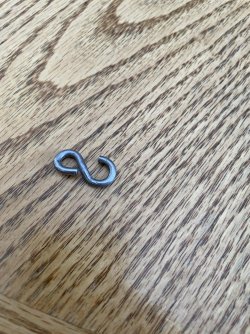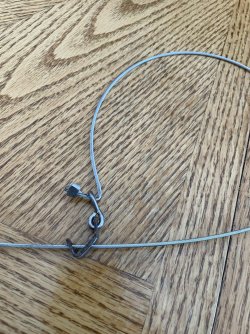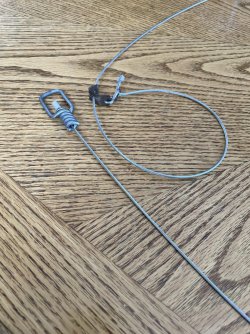-
If you are being asked to change your password, and unsure how to do it, follow these instructions. Click here
You are using an out of date browser. It may not display this or other websites correctly.
You should upgrade or use an alternative browser.
You should upgrade or use an alternative browser.
Ramblings and Such From Hunting Coyote
- Thread starter DSheetz
- Start date
 Help Support Long Range Hunting Forum
Help Support Long Range Hunting Forum
- Joined
- Nov 25, 2012
- Messages
- 316
Windypants,
If you're in cattle country, try some calf distress/bawls.
In cooler/cold weather I've had some luck getting them to pop up for a look to see if it's worth their time to join in on a kill.
Piglet distress works well, too if you have feral pigs around.
They are probably popping up, but only enough for them to see, not presenting much to shoot at. Think prairie dogs that have been shot at. They'll stick just enough head and eyes to see above the rim of the mound.
I had one a few years back on the Delaware River bottom that frustrated me to no end for about 45 minutes. He was answering me with barks, but I couldn't see him. I had started with a couple of howls, waited a bit, then cut loose on my e-caller with piglet distress. That triggered the barks, probably trying to figure out how many other coyotes might be down there.
I slowed down and started methodically glassing the hillside across from me. I finally spotted him at just over 400 lasered yards, with just his ears, the top of his head, and his eyes sticking up above the crown of the ridge. I couldn't shoot because there was oilfield activity about a half mile behind him and I didn't want to miss him and launch a round into the crew working back there.
Sometimes the promise of a big, quick meal will get them to show when other things don't.
Ed
If you're in cattle country, try some calf distress/bawls.
In cooler/cold weather I've had some luck getting them to pop up for a look to see if it's worth their time to join in on a kill.
Piglet distress works well, too if you have feral pigs around.
They are probably popping up, but only enough for them to see, not presenting much to shoot at. Think prairie dogs that have been shot at. They'll stick just enough head and eyes to see above the rim of the mound.
I had one a few years back on the Delaware River bottom that frustrated me to no end for about 45 minutes. He was answering me with barks, but I couldn't see him. I had started with a couple of howls, waited a bit, then cut loose on my e-caller with piglet distress. That triggered the barks, probably trying to figure out how many other coyotes might be down there.
I slowed down and started methodically glassing the hillside across from me. I finally spotted him at just over 400 lasered yards, with just his ears, the top of his head, and his eyes sticking up above the crown of the ridge. I couldn't shoot because there was oilfield activity about a half mile behind him and I didn't want to miss him and launch a round into the crew working back there.
Sometimes the promise of a big, quick meal will get them to show when other things don't.
Ed
windypants
Well-Known Member
Thanks fellas. I think I've probably been calling too much. I could get them to talk with group howls and pair howls, but they seemed to just keep going where they were going. I guess I need to think in terms of making them curious rather than calling them out. It's cattle country here, but no feral pigs or sheep. And calving season starts soon, so I know they'll being hanging around calving pastures a lot. I'll keep experimenting with coyote and non coyote sounds to see what works. My hunting methods have been effective at getting wary and call shy coyotes, because they have no idea I'm around if I hunt the wind and just peek into their territory from ridges. But there are times when I know where they are and think there must be some way to get them to expose themselves.
- Joined
- Nov 25, 2012
- Messages
- 316
The two biggest mistakes folks make are calling too much and calling too loud.
I know, because I was guilty of both for a while until an old trapper rode with me one day and didn't say a word while we got skunked.
That evening he asked if I wanted to try again the next day except that he would do all the calling.
Being slightly smarter than a sack of hammers, I said yes!
We went right back to the sets we had made the day before and killed seven coyotes out of the dozen or so we called in.
Brute force calling just educated coyotes, subtle calling gets them dead.
If you have dogs, you know that they can have days that they are sharper than a needle and other days they are as sharp as a basketball.
Coyotes are no different.
I've had them walk right towards me when I was standing in the open, with their heads down, probably tracking something, and get within 50 yards before realizing that something was not right. I'm not talking about a juvenile, but an older adult coyote.
Keep at it, you're on the right track!
When you learn something new, please share it!
None of us are too old to learn and none of us can't use a reminder.
Ed
I know, because I was guilty of both for a while until an old trapper rode with me one day and didn't say a word while we got skunked.
That evening he asked if I wanted to try again the next day except that he would do all the calling.
Being slightly smarter than a sack of hammers, I said yes!
We went right back to the sets we had made the day before and killed seven coyotes out of the dozen or so we called in.
Brute force calling just educated coyotes, subtle calling gets them dead.
If you have dogs, you know that they can have days that they are sharper than a needle and other days they are as sharp as a basketball.
Coyotes are no different.
I've had them walk right towards me when I was standing in the open, with their heads down, probably tracking something, and get within 50 yards before realizing that something was not right. I'm not talking about a juvenile, but an older adult coyote.
Keep at it, you're on the right track!
When you learn something new, please share it!
None of us are too old to learn and none of us can't use a reminder.
Ed
Especially with the e-callers. It took me forever to figure it out on my own, by the cats, coyotes and fox telling me over and over to back off with the volume and length of time calling and resting between calling sequences. I had to listen to the actual animals and how they would talk everything gets tired or dies that is making distress sounds, everything that is just talking to someone else, does it in lower tones and not as much as one would think. Yes, please share with us all things that you are experiencing and figuring out.
trapper1954
Well-Known Member
That reminds me of a time up on the Brazos with my father in law favorite Jim Putnam. He wanted to call some coyotes and so we went to his families place which had Camp Cooper on it, we were next to a ranch called the Lambs Head and the only place we could find to set up was next to a 6 tank battery with a flare. Big pumping station 2 miles east of us, loud as all hell. Hopeless I swear but I gave a 500 pound rabbit and zap,,, coyote 50 yards,, less than 60 seconds, dead stopped and father in law froze like a rock, too much too fast, he finally got off a running shot and missed by a mile.. Ha haWindypants,
If you're in cattle country, try some calf distress/bawls.
In cooler/cold weather I've had some luck getting them to pop up for a look to see if it's worth their time to join in on a kill.
Piglet distress works well, too if you have feral pigs around.
They are probably popping up, but only enough for them to see, not presenting much to shoot at. Think prairie dogs that have been shot at. They'll stick just enough head and eyes to see above the rim of the mound.
I had one a few years back on the Delaware River bottom that frustrated me to no end for about 45 minutes. He was answering me with barks, but I couldn't see him. I had started with a couple of howls, waited a bit, then cut loose on my e-caller with piglet distress. That triggered the barks, probably trying to figure out how many other coyotes might be down there.
I slowed down and started methodically glassing the hillside across from me. I finally spotted him at just over 400 lasered yards, with just his ears, the top of his head, and his eyes sticking up above the crown of the ridge. I couldn't shoot because there was oilfield activity about a half mile behind him and I didn't want to miss him and launch a round into the crew working back there.
Sometimes the promise of a big, quick meal will get them to show when other things don't.
Ed
trapper1954
Well-Known Member
My dad had a old Burnam Bros. call when I was 6 or 8 and he love calling foxes. He tore up every wore out doll he could find making something different. He had a little box of parts and I wound up with that stuff and switched things all around to make a different sound myself. My first coyote I called in was a mid day on a homemade squealer and I was 13, never got a shot he put the slip on me. When I as around 18 or so I went to the easy way, cassett and the famous wounded wood pecker and slaughtered the foxes. I stuck with e-callers until I noticed everywhere I could hunt, the varmints were now educated, glimpses of an eye once, night calling, flash of a ghost y movement by day so I got a 3 piece calling kit from Cabelas 2 open reeds and a squeaker. The squeaker was good and the wood pecker deal works 1/2 way but just didnt cut it. I saw some calls James Lucero had made for my friend J.H. and we killed coyotes by day 75% of the time, important coyotes I might add. I built my own from antler pieces and cow horns, even goat horns. I made some changes to my design and have used my calls in all the competition I've been in and I'm satisfied. I will tell you guys who are out there, if the cowboys are tipping at the pens, scarf up a feed sack full and pm me.Especially with the e-callers. It took me forever to figure it out on my own, by the cats, coyotes and fox telling me over and over to back off with the volume and length of time calling and resting between calling sequences. I had to listen to the actual animals and how they would talk everything gets tired or dies that is making distress sounds, everything that is just talking to someone else, does it in lower tones and not as much as one would think. Yes, please share with us all things that you are experiencing and figuring out.
Mescalero/Reconero
I ordered a dozen Thompson snares 1-4-2024. I got them 1-18-2024. I have to use breakaways here, Thompson makes a breakaway device, but I didn't order any of them. I have a bunch of breakaways already, so I just modified them to work with the new snares. The snares that I ordered were 5/64 x 1x19 cable at 96 inches long. A standard s-hook breakaway, an s-hook breakaway turned 90 degrees on one end to fit the Thompson snare lock, the snare as it came, the snare with the breakaway installed, and the snare with a swivel installed. The swivel is just used as a way to fasten the snare in place as it doesn't work within a few seconds as the animal tangles the cable and it is made immobile.
Attachments
Last edited:
I will use them and see how well they perform in my situation as compared to the aircraft cable that I'm used to. I know that it doesn't open up as easily as the 7x7x21 and if it does it isn't as easily chewed into. I will probably wait till spring or early summer to first try them when I don't have to contend with bad weather freezing ground and snow drifting. Because they will have a learning curve like any other tool.
- Joined
- Nov 25, 2012
- Messages
- 316
The last two batches of 7x7 cable I used were junk. Yes, it is easier to use than the 1x19, but I had chew-outs and more tangled up messes than anything I've had in the past.
I'm switching to 1x19 for my snares!
Breakaways, IMHO, are a good thing. I'd rather have a torn up snare than a calf, deer, or an Antelope caught in one of my snares.
I'm supposed to be protecting them, not adding risk to them.
Ed
I'm switching to 1x19 for my snares!
Breakaways, IMHO, are a good thing. I'd rather have a torn up snare than a calf, deer, or an Antelope caught in one of my snares.
I'm supposed to be protecting them, not adding risk to them.
Ed
I really don't mind using breakaways. As you say we are protecting some animals by killing others and I preferer to keep those animals in my sets, that need to be in my snares, and not have one get out of a snare or go off someplace with a snare on it to die a miserable death. Ed, have you tried cam-locks on the 1x19 cable? I found the Chinese cable wasn't much good in the 7x7 myself it really didn't have the advertised breaking strength and tended to untwist and open up then break easier. I don't think it really was made of the good quality 5160 steel as it should be.
ohlongarmisle
Well-Known Member
Looking forward to your results,I will never deviate from Thompsons,as my success has been stellar.I will use them and see how well they perform in my situation as compared to the aircraft cable that I'm used to. I know that it doesn't open up as easily as the 7x7x21 and if it does it isn't as easily chewed into. I will probably wait till spring or early summer to first try them when I don't have to contend with bad weather freezing ground and snow drifting. Because they will have a learning curve like any other tool.




